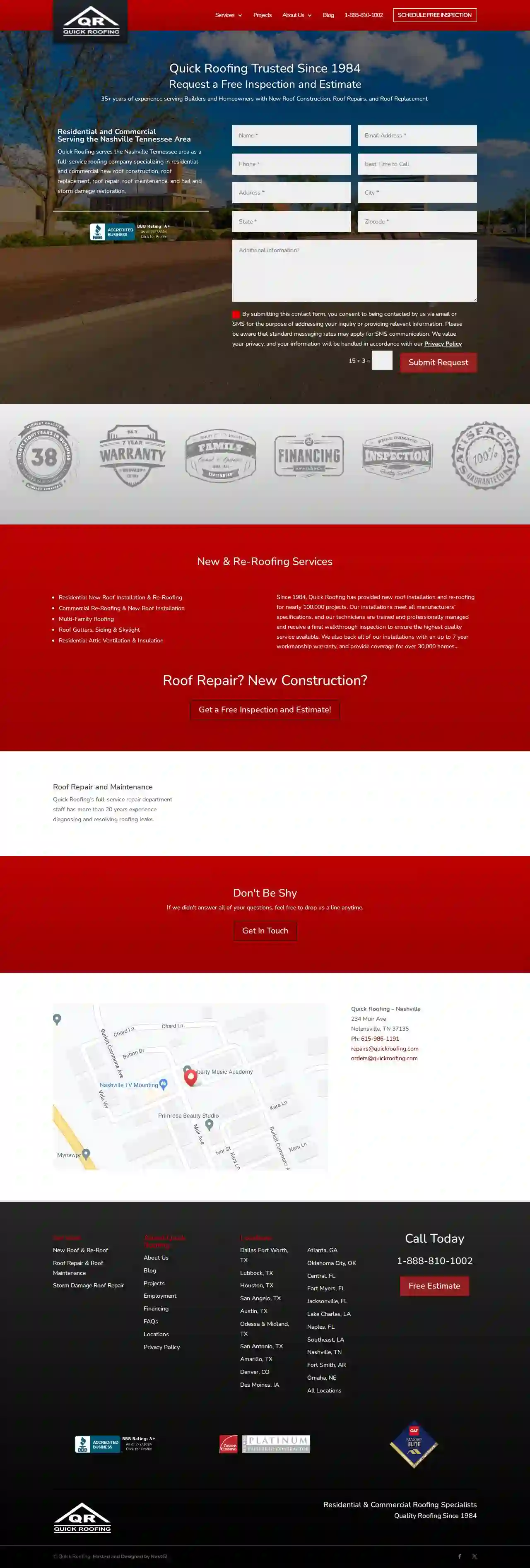Roofing Companies Lake Tansi
Find Roofers in Lake Tansi
Receive up to 3 Roofing Services quotes for your project today! Compare profiles, reviews, accreditations, portfolio, etc... and choose the best service.

Best Choice Roofing
4.7213 reviews1756 Jardco Dr. Suite D, Clarksville, 37040, USBest Choice Roofing is a trusted roofing contractor with over 60,000 grateful customers. We are the nation's largest Platinum Roofer, offering premium roofing services, including residential and commercial roofing, weather damage repair, siding, and gutters. Our team of experts is dedicated to providing exceptional service and ensuring customer satisfaction. With offices in over 65 cities, we are committed to being a local roofing company that you can trust. Contact us today to schedule a free inspection and learn more about our services, warranties, and financing options.
- Services
- Why Us?
- Gallery
Get Quote
Quick Roofing - Nashville
4.425 reviews234 Muir Ave, Nolensville, 37135, USQuick Roofing is a full-service roofing company serving the Nashville, Tennessee area. With over 35 years of experience, they specialize in new roof construction, roof replacement, roof repair, roof maintenance, and hail and storm damage restoration for both residential and commercial properties. They pride themselves on meeting all manufacturer specifications and providing high-quality service backed by a workmanship warranty. Quick Roofing has completed nearly 100,000 projects and has a team of experienced technicians who undergo thorough training and final walkthrough inspections to ensure customer satisfaction.
- Services
- Why Us?
- Accreditations
- Gallery
Get Quote
ATD Roofing
1200 Woodruff Rd, Suite C-38, Greenville, 29607, USATD Roofing is a full-service licensed and bonded Commercial and Residential General Contractor, providing roofing, siding, and restoration services. With a team of construction professionals, they offer expertise in residential and commercial projects of any size. They are certified and licensed Specialty Roofer, providing technical roofing including structural work, persistent leaks, and construction repair. They also offer financing options and assistance with insurance claims.
- Services
- Why Us?
- Testimonials
- Gallery
Get Quote
Cumberland Commercial Roofing LLC
53 reviews1375 Pembroke Fairview Rd., Pembroke, 42266, USCumberland Commercial Roofing is a trusted name in commercial roofing services. We are dedicated to providing high-quality workmanship and exceptional customer service to our clients in Pembroke, Kentucky, and the surrounding areas. Our team of experienced and certified roofing professionals is committed to staying up-to-date with the latest industry trends and technologies to ensure that we deliver the best possible results for every project. We offer a comprehensive range of roofing services, including roof replacement, repair, restoration, and maintenance. Whether you need a new roof installation, emergency repairs, or routine maintenance, we have the expertise and resources to handle your needs. At Cumberland Commercial Roofing, we understand that your roof is a vital investment in your property. That's why we use only the highest quality materials and products, backed by industry-leading warranties. We are fully licensed and insured, providing you with peace of mind knowing that your project is in safe hands. Our commitment to quality, integrity, and innovation sets us apart from the competition. We work closely with our clients to understand their unique needs and provide customized solutions that meet their specific requirements. Contact us today for a free consultation and let us help you protect your investment with a durable and reliable roof system.
- Services
- Why Us?
- Gallery
Get Quote
Bellator Roofing & restoration llc
519 reviews1016 Russwood Dr SW, Knoxville, 37920, USAt Bellator Roofing and Restoration, we understand that your home or business is one of your most significant investments, and protecting it starts with a reliable roof. With years of experience in the industry, we are dedicated to providing top-notch roofing solutions tailored to your specific needs. Why Choose Us? * **Expertise:** Our team consists of highly skilled professionals with extensive knowledge in all aspects of roofing. From installation to repair and maintenance, we have the expertise to handle any project, big or small. * **Quality Materials:** We believe in using only the highest quality materials for every job we undertake. This ensures durability, longevity, and ultimately, your satisfaction. * **Customer Satisfaction:** Your satisfaction is our priority. We work closely with you throughout the entire process to ensure your vision becomes a reality. Our commitment to excellence means we won’t rest until you’re 100% satisfied with the results. * **Affordable Pricing:** We believe that everyone deserves a sturdy, reliable roof without breaking the bank. That’s why we offer competitive pricing without compromising on quality. * **Timely Service:** We understand the importance of timeliness, especially when it comes to roofing issues. You can rely on us to complete your project on schedule, without sacrificing quality. Call us today at 615-934-1421 when you need reliable roofing repairs.
- Services
- Why Us?
- Gallery
Get Quote
Mighty Metal Roofing
4.619 reviewsMemphis, USMighty Metal Roofing is a locally owned and operated roofing company serving the Memphis area. With over 25 years of experience, they specialize in metal roofing and are considered the Mid-South metal roofing experts. They offer free estimates and roof inspections, and their team is committed to providing quality products and professional installation. Mighty Metal Roofing also offers financing options to make their services accessible to a wider range of customers. Beyond metal roofing, they provide other services such as shingle roofing, energy-efficient windows, and vinyl siding. The company prides itself on its customer service, as evidenced by numerous positive testimonials from satisfied clients who praise their professionalism, quality workmanship, and responsiveness. Mighty Metal Roofing is dedicated to helping homeowners move their homes forward with quality products and reliable service.
- Services
- Why Us?
- Accreditations
- Our Team
- Testimonials
- Gallery
Get Quote
Scott Roofing Company
51 reviewsNashville, USScott Roofing Company is a family-owned roofing business that has been serving the community for over 20 years. Our founder started this business with a passion for providing quality roofing services at affordable prices. We offer a wide range of roofing services, including roof repairs, roof installations, and roof replacements. We use only the highest-quality materials and our team of experts ensures a job well done every time. Our mission is to provide exceptional roofing services to our customers while maintaining the highest level of integrity and professionalism. We strive to exceed our customers' expectations and leave them completely satisfied with our work. We stay in constant communication with our customers until the job is done. To get a free quote, or if you have questions or special requests, just drop us a line.
- Services
- Why Us?
- Gallery
Get Quote
MHM ROOFING
513 reviews123 Main St, Los Angeles, 90210, USMHM Roofing is a family-owned and operated roofing company serving the greater [City] area. We are committed to providing our customers with the highest quality roofing services at competitive prices. Our team of experienced roofers has the knowledge and expertise to handle all of your roofing needs, from small repairs to complete roof replacements. We use only the best materials and workmanship to ensure that your roof is built to last.
- Services
- Why Us?
Get Quote
The Knoxville Roofing Company
Knoxville, Knoxville, TN, USA, USThe Knoxville Roofing Company is a professional roofing company serving Knoxville, TN, and surrounding areas. With over 100 years of combined roofing experience, our team can handle any type of roofing, whether residential or commercial. We offer complete services to homeowners, including roof repair, roof installation, and roof replacement. Our roofers are highly skilled in all areas of roofing, including replacement, installation, emergency repair, and storm damage repair. We work with almost every type of roofing material, including tile, slate, shingle, cedar shake, metal roofs, and more. We pride ourselves on the high quality of workmanship, work with trusted brands in roofing, and offer a five-year labor warranty with our services. Call us today to get a free estimate!
- Services
- Why Us?
- Gallery
Get Quote
Turner Exteriors, LLC
4.758 reviewsCorryton, USHelping with Your Home Exterior Needs Get a Free Consultation For more information on our services, call or text now for a FREE in-home consultation. Our number is (865) 438-5050. Do you need help with your roofing or gutters? Then get in touch with a top roofing company near Corryton, TN. At Turner Exteriors, we’re prepared to help with residential shingle and metal roofing, gutters, and more. We are roofing and gutter specialists that refuse to cut corners; when you work with us, you can be confident the job will be done right. We have over 33 years of professional experience in the field. We always go above and beyond to assist with your needs. We have the skill and knowledge to ensure a fantastic installation. We use the highest-quality materials available for your project. From siding installation to decking work, we’re confident we can handle the job perfectly. Our process helps us to ensure that the process is done perfectly; we use premium materials, top-of-the-line tools, and put an emphasis on excellent work. Plus, we provide you with outstanding service long after the initial job, handling warranty issues and more. Why Pick Turner Exteriors? We Can Help with Everything from Roofing to Gutters Residential Shingle Roofing Turner Exteriors can do all your residential roofing work. We can even do designer shingle roofing and 3D shingles with two layers. Give us a call today to request your free in-home consultation and learn more. Gutter Installation Service Trust our experts to install your aluminum gutters along your home's perimeter. We guarantee all workmanship and materials, so you can rest assured our gutter installation will last for years to come. Residential Metal Roofing When doing your roofs, we offer more than just an attractive metal roof. A selection of standing seam and rib panel styles is available to fit any home. Get a free in-home consultation today. Leaf Guard Installation We work with Leaf Relief, a premium type of leaf guard. Contact us to know more about this effective gutter protection. Our experts are standing by to answer any questions you have about this product. Siding & Windows You can trust the team at Turner Exteriors to design and install siding that will increase your energy efficiency, upgrade the
- Services
- Why Us?
- Accreditations
- Gallery
Get Quote
Over 17,196+ Roofers on our directory
Our roofing contractors operate in Lake Tansi and surrounding areas!
Roofyng.com has curated and vetted Top Roofing Contractors near Lake Tansi. Find a top & reliable business today.
Frequently Asked Questions About Roofing Companies
- Leaks or Water Stains: Water stains on ceilings or walls, dripping water, or dampness in the attic.
- Missing, Cracked, or Curled Shingles: Inspect for damaged or missing shingles, especially after a storm.
- Damaged Flashing: Look for rust, corrosion, or gaps in flashing around chimneys, vents, or skylights.
- Sagging or Uneven Rooflines: A sagging roof could indicate structural problems.
- Granule Loss: Excessive granules in gutters suggest aging asphalt shingles.
- Moss or Algae Growth: Can trap moisture and damage roofing materials.
- Listed Buildings: Buildings with historical or architectural significance.
- Conservation Areas: Areas with special architectural or historical character.
- Changes to Roof Design: If you're making significant alterations to the roof's design, such as adding a dormer window or changing the pitch.
- Regular Inspections: Inspect your roof at least twice a year for signs of damage or wear and tear.
- Gutter Cleaning: Clean gutters and downspouts regularly to prevent clogs and ensure proper drainage.
- Tree Trimming: Trim overhanging branches to avoid damage from falling debris and reduce shade, preventing moss growth.
- Proper Ventilation: Ensure good attic ventilation to regulate temperature and moisture.
- Timely Repairs: Address any damage promptly to prevent escalation.
- Age: If your roof is nearing or exceeding its expected lifespan, it's wise to consider replacement.
- Multiple Leaks: Several leaks or leaks that reappear after repairs suggest a widespread problem.
- Extensive Damage: Large areas of damaged, missing, or deteriorated roofing materials might be too costly or difficult to repair effectively.
- Sagging or Structural Issues: Sagging, deflection, or other structural issues indicate a compromised roof that needs replacement.
- Granule Loss (Asphalt Shingles): Significant granule loss indicates weathering and reduced protection.
- Curling or Buckling Shingles: Signifies age or improper ventilation.
- Increased Energy Bills: A poorly insulated roof can lead to higher heating and cooling costs.
What are some common signs of roof damage?
Do I need planning permission to replace my roof in the USA?
How do I prevent roof damage?
What are the signs that my roof needs to be replaced?
What are some common signs of roof damage?
- Leaks or Water Stains: Water stains on ceilings or walls, dripping water, or dampness in the attic.
- Missing, Cracked, or Curled Shingles: Inspect for damaged or missing shingles, especially after a storm.
- Damaged Flashing: Look for rust, corrosion, or gaps in flashing around chimneys, vents, or skylights.
- Sagging or Uneven Rooflines: A sagging roof could indicate structural problems.
- Granule Loss: Excessive granules in gutters suggest aging asphalt shingles.
- Moss or Algae Growth: Can trap moisture and damage roofing materials.
Do I need planning permission to replace my roof in the USA?
- Listed Buildings: Buildings with historical or architectural significance.
- Conservation Areas: Areas with special architectural or historical character.
- Changes to Roof Design: If you're making significant alterations to the roof's design, such as adding a dormer window or changing the pitch.
How do I prevent roof damage?
- Regular Inspections: Inspect your roof at least twice a year for signs of damage or wear and tear.
- Gutter Cleaning: Clean gutters and downspouts regularly to prevent clogs and ensure proper drainage.
- Tree Trimming: Trim overhanging branches to avoid damage from falling debris and reduce shade, preventing moss growth.
- Proper Ventilation: Ensure good attic ventilation to regulate temperature and moisture.
- Timely Repairs: Address any damage promptly to prevent escalation.
What are the signs that my roof needs to be replaced?
- Age: If your roof is nearing or exceeding its expected lifespan, it's wise to consider replacement.
- Multiple Leaks: Several leaks or leaks that reappear after repairs suggest a widespread problem.
- Extensive Damage: Large areas of damaged, missing, or deteriorated roofing materials might be too costly or difficult to repair effectively.
- Sagging or Structural Issues: Sagging, deflection, or other structural issues indicate a compromised roof that needs replacement.
- Granule Loss (Asphalt Shingles): Significant granule loss indicates weathering and reduced protection.
- Curling or Buckling Shingles: Signifies age or improper ventilation.
- Increased Energy Bills: A poorly insulated roof can lead to higher heating and cooling costs.